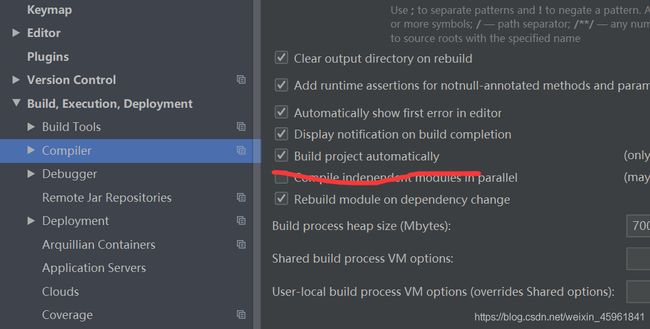蒟蒻のSpring小窝(SpringBoot)01-spring初体验
开坑 有空填—2020.04.01
今天更新vue0.2
SpringBoot每个JAVA开发工程师必备框架知识,简化了Spring的xmlbean,上手友好 。。。看访问量涨的快,我更一下。
01.开始:
SpringBoot配置devtools实现热部署
spring为开发者提供了一个名为spring-boot-devtools的模块来使Spring Boot应用支持热部署,提高开发者的开发效率,无需手动重启Spring Boot应用。
devtools的原理
深层原理是使用了两个ClassLoader,一个Classloader加载那些不会改变的类(第三方Jar包),另一个ClassLoader加载会更改的类,称为restart ClassLoader,这样在有代码更改的时候,原来的restart ClassLoader 被丢弃,重新创建一个restart ClassLoader,由于需要加载的类相比较少,所以实现了较快的重启时间。
使用需要添加以下的配置:
org.springframework.boot
spring-boot-devtools
true
org.springframework.boot
spring-boot-starter-web
org.springframework.boot
spring-boot-starter-test
test
org.springframework.boot
spring-boot-maven-plugin
true
说明:
(1) devtools可以实现页面热部署(即页面修改后会立即生效,这个可以直接在application.properties文件中配置spring.thymeleaf.cache=false来实现),
实现类文件热部署(类文件修改后不会立即生效),实现对属性文件的热部署。
即devtools会监听classpath下的文件变动,并且会立即重启应用(发生在保存时机),注意:因为其采用的虚拟机机制,该项重启是很快的
(2)配置了true后在修改java文件后也就支持了热启动,不过这种方式是属于项目重启(速度比较快的项目重启),会清空session中的值,也就是如果有用户登陆的话,项目重启后需要重新登陆。
默认情况下,/META-INF/maven,/META-INF/resources,/resources,/static,/templates,/public这些文件夹下的文件修改不会使应用重启,但是会重新加载(devtools内嵌了一个LiveReload server,当资源发生改变时,浏览器刷新)。
devtools的配置
在application.properties中配置spring.devtools.restart.enabled=false,此时restart类加载器还会初始化,但不会监视文件更新。
在SprintApplication.run之前调用System.setProperty(“spring.devtools.restart.enabled”, “false”);可以完全关闭重启支持,配置内容:
#热部署生效
spring.devtools.restart.enabled: true
#设置重启的目录
#spring.devtools.restart.additional-paths: src/main/java
#classpath目录下的WEB-INF文件夹内容修改不重启
spring.devtools.restart.exclude: WEB-INF/**
IDEA配置
当我们修改了Java类后,IDEA默认是不自动编译的,而spring-boot-devtools又是监测classpath下的文件发生变化才会重启应用,所以需要设置IDEA的自动编译:
(1)File-Settings-Compiler-Build Project automatically

把这个给点了,有些版本idea好像叫做make project automatically我的是19.3的 ,这个你们根据需要。
(2)ctrl + shift + alt + /,选择Registry,勾上 Compiler autoMake allow when app running

小测试:
修改类–>保存:应用会重启
修改配置文件–>保存:应用会重启
修改页面–>保存:应用不会重启,但会重新加载,页面会刷新
THEMELEAF介绍
(一)Thymeleaf 是个什么?
简单说, Thymeleaf 是一个跟 Velocity、FreeMarker 类似的模板引擎,它可以完全替代 JSP 。相较与其他的模板引擎,它有如下三个极吸引人的特点:
1.Thymeleaf 在有网络和无网络的环境下皆可运行,即它可以让美工在浏览器查看页面的静态效果,也可以让程序员在服务器查看带数据的动态页面效果。这是由于它支持 html 原型,然后在 html 标签里增加额外的属性来达到模板+数据的展示方式。浏览器解释 html 时会忽略未定义的标签属性,所以 thymeleaf 的模板可以静态地运行;当有数据返回到页面时,Thymeleaf 标签会动态地替换掉静态内容,使页面动态显示。
2.Thymeleaf 开箱即用的特性。它提供标准和spring标准两种方言,可以直接套用模板实现JSTL、 OGNL表达式效果,避免每天套模板、该jstl、改标签的困扰。同时开发人员也可以扩展和创建自定义的方言。
3. Thymeleaf 提供spring标准方言和一个与 SpringMVC 完美集成的可选模块,可以快速的实现表单绑定、属性编辑器、国际化等功能。
(二)应用
1.简单的 Thymeleaf 应用
1)只需加入thymeleaf-2.1.4.RELEASE.jar(http://www.thymeleaf.org/download.html )包,若用maven,则加入如下配置
<dependency>
<groupId>org.thymeleaf</groupId>
<artifactId>thymeleaf</artifactId>
<version>2.1.4</version>
</dependency>
2)然后增加头文件(如下)
<!DOCTYPE html>
<html xmlns="http://www.w3.org/1999/xhtml"
xmlns:th="http://www.thymeleaf.org">
3)就可以用th标签动态替换掉静态数据了。如下图,后台传出的message会将静态数据“Red Chair”替换掉,若访问静态页面,则显示数据“Red Chair”。
<td th:text="${message}">Red Chair</td>
2.整合spring
1)加入thymeleaf-spring4-2.1.4.RELEASE.jar(http://www.thymeleaf.org/download.html )包,若用maven,则加入如下配置
<dependency>
<groupId>org.thymeleaf</groupId>
<artifactId>thymeleaf-spring3</artifactId>
<version>2.1.4</version>
</dependency>
2)在servlet配置文件中加入如下代码
<!-- Scans the classpath of this application for @Components to deploy as beans -->
<context:component-scan base-package="com.test.thymeleaf.controller" />
<!-- Configures the @Controller programming model -->
<mvc:annotation-driven />
<!--Resolves view names to protected .jsp resources within the /WEB-INF/views directory -->
<!--springMVC+jsp的跳转页面配置-->
<!--<bean class="org.springframework.web.servlet.view.InternalResourceViewResolver">-->
<!--<property name="prefix" value="/WEB-INF/views/" />-->
<!--<property name="suffix" value=".jsp" />-->
<!--</bean>-->
<!--springMVC+thymeleaf的跳转页面配置-->
<bean id="templateResolver"
class="org.thymeleaf.templateresolver.ServletContextTemplateResolver">
<property name="prefix" value="/WEB-INF/views/" />
<property name="suffix" value=".html" />
<property name="templateMode" value="HTML5" />
</bean>
<bean id="templateEngine"
class="org.thymeleaf.spring4.SpringTemplateEngine">
<property name="templateResolver" ref="templateResolver" />
</bean>
<bean class="org.thymeleaf.spring4.view.ThymeleafViewResolver">
<property name="templateEngine" ref="templateEngine" />
</bean>
3)将静态页面加到项目中,更改文件头,加入th标签即可。
3.th标签整理
1)简单表达式
--变量表达式 ${……}
<input type="text" name="userName" value="James Carrot" th:value="${user.name}" />
上述代码为引用user对象的name属性值。
--选择/星号表达式 *{……}
<div th:object="${session.user}">
<p>Nationality: <span th:text="*{nationality}">Saturn</span>.</p>
</div>
选择表达式一般跟在th:object后,直接取object中的属性。
--文字国际化表达式 #{……}
<p th:utext="#{home.welcome}">Welcome to our grocery store!</p>
调用国际化的welcome语句,国际化资源文件如下
resource_en_US.properties:
home.welcome=Welcome to here!
resource_zh_CN.properties:
home.welcome=欢迎您的到来!
– URL表达式 @{……}
<a href="details.html" th:href="@{/order/details(orderId=${o.id})}">view</a>
@{……}支持决定路径和相对路径。其中相对路径又支持跨上下文调用url和协议的引用(//code.jquery.com/jquery-2.0.3.min.js)。
当URL为后台传出的参数时,代码如下
<img src="../../static/assets/images/qr-code.jpg" th:src="@{${path}}" alt="二维码" />
2)常用的th标签
--简单数据转换(数字,日期)
```java
<dt>价格</dt>
<dd th:text="${#numbers.formatDecimal(product.price, 1, 2)}">180</dd>
<dt>进货日期</dt>
<dd th:text="${#dates.format(product.availableFrom, 'yyyy-MM-dd')}">2020-04-01</dd>
–字符串拼接
<dd th:text="${'$'+product.price}">235</dd>
–转义和非转义文本
当后台传出的数据为“This is an HTML text. Enjoy yourself!”时,若页面代码如下则出现两种不同的结果
<div th:text="${html}">
This is an <em>HTML</em> text. <b>Enjoy yourself!</b>
</div>
<div th:utext="${html}">
This is an <em>HTML</em> text. <b>Enjoy yourself!</b>
</div>
–表单中
<form th:action="@{/bb}" th:object="${user}" method="post" th:method="post">
<input type="text" th:field="*{name}"/>
<input type="text" th:field="*{msg}"/>
<input type="submit"/>
</form>
–显示页面的数据迭代
//用 th:remove 移除除了第一个外的静态数据,用第一个tr标签进行循环迭代显示
<tbody th:remove="all-but-first">
//将后台传出的 productList 的集合进行迭代,用product参数接收,通过product访问属性值
<tr th:each="product:${productList}">
//用count进行统计,有顺序的显示
<td th:text="${productStat.count}">1</td>
<td th:text="${product.description}">Red Chair</td>
<td th:text="${'$' + #numbers.formatDecimal(product.price, 1, 2)}">$123</td>
<td th:text="${#dates.format(product.availableFrom, 'yyyy-MM-dd')}">2014-12-01</td>
</tr>
<tr>
<td>White table</td>
<td>$200</td>
<td>15-Jul-2013</td>
</tr>
<tr>
<td>Reb table</td>
<td>$200</td>
<td>15-Jul-2013</td>
</tr>
<tr>
<td>Blue table</td>
<td>$200</td>
<td>15-Jul-2013</td>
</tr>
</tbody>
–条件判断
<span th:if="${product.price lt 100}" class="offer">Special offer!</span>
不能用"<”,">"等符号,要用"lt"等替代
<!-- 当gender存在时,选择对应的选项;若gender不存在或为null时,取得customer对象的name-->
<td th:switch="${customer.gender?.name()}">
<img th:case="'MALE'" src="../../../images/male.png" th:src="@{/images/male.png}" alt="Male" /> <!-- Use "/images/male.png" image -->
<img th:case="'FEMALE'" src="../../../images/female.png" th:src="@{/images/female.png}" alt="Female" /> <!-- Use "/images/female.png" image -->
<span th:case="*">Unknown</span>
</td>
<!--在页面先显示,然后再在显示的数据基础上进行修改-->
<div class="form-group col-lg-6">
<label>姓名<span> </span></label>
<!--除非resume对象的name属性值为null,否则就用name的值作为placeholder值-->
<input type="text" class="form-control" th:unless="${resumes.name} eq '' or ${resumes.name} eq null"
data-required="true" th:placeholder="${resumes.name}" />
<!--除非resume对象的name属性不为空,否则就定义一个field方便封装对象,并用placeholder提示-->
<input type="text" th:field="${resume.name}" class="form-control" th:unless="${resumes.name} ne null"
data-required="true" th:placeholder="请填写您的真实姓名" />
</div>
<!-- 增加class="enhanced"当balance大雨10000 -->
<td th:class="${customer.balance gt 10000} ? 'enhanced'" th:text="${customer.balance}">350</td>
<div class="form-group col-lg-6">
<label >性别<span> Sex:</span></label>
<select th:field="${resume.gender}" class="form-control" th:switch="${resumes.gender.toString()}"
data-required="true">
<option value="男" th:case="'男'" th:selected="selected" >男</option>
<option value="女" th:case="'女'" th:selected="selected" >女</option>
<option value="">请选择</option>
</select>
</div>
因为gender是定义的Enum(枚举)类型,所以要用toString方法。用th:switch指定传出的变量,用th:case对变量的值进行匹配。!"请选择"放在第一项会出现永远选择的是这个选项。或者用th:if
<div class='form-group col-lg-4'>
<select class='form-control' name="skill[4].proficiency">
<option >掌握程度</option>
<option th:if="${skill.level eq '一般'}" th:selected="selected">一般</option>
<option th:if="${skill.level eq '熟练'}" th:selected="selected">熟练</option>
<option th:if="${skill.level eq '精通'}" th:selected="selected">精通</option>
</select>
</div>
–spring表达式语言
<!DOCTYPE html>
<html xmlns:th="http://www.thymeleaf.org">
<head>
<title>Thymeleaf tutorial: exercise 10</title>
<link rel="stylesheet" href="../../../css/main-static.css" th:href="@{/css/main.css}" />
<meta charset="utf-8" />
</head>
<body>
<h1>Thymeleaf tutorial - Solution for exercise 10: Spring Expression language</h1>
<h2>Arithmetic expressions</h2>
<p class="label">Four multiplied by minus six multiplied by minus two module seven:</p>
<p class="answer" th:text="${4 * -6 * -2 % 7}">123</p>
<h2>Object navigation</h2>
<p class="label">Description field of paymentMethod field of the third element of customerList bean:</p>
<p class="answer" th:text="${customerList[2].paymentMethod.description}">Credit card</p>
<h2>Object instantiation</h2>
<p class="label">Current time milliseconds:</p>
<p class="answer" th:text="${new java.util.Date().getTime()}">22-Jun-2013</p>
<h2>T operator</h2>
<p class="label">Random number:</p>
<p class="answer" th:text="${T(java.lang.Math).random()}">123456</p>
</body>
</html>
–内联
<label for="body">Message body:</label>
<textarea id="body" name="body" th:inline="text">
Dear [[${customerName}]],
it is our sincere pleasure to congratulate your in your birthday:
Happy birthday [[${customerName}]]!!!
See you soon, [[${customerName}]].
Regards,
The Thymeleaf team
</textarea>
–内联JS
/*
……
/*]]>*/
–js附加代码
/*[+
var msg = 'This is a working application';
+]*/
–js移除代码:
/*[- */
var msg = 'This is a non-working template';
/* -]*/
4.不常用
--表达式
2)文字
a)文本文字 'one text','Another one',……
b)数字文字 0,34,3.0,12.3,……
c)布尔文字 true,flase
d)空文字 null
e)文字标记 one,sometext,main,……
3)文本处理
a)字符串连接 +
b)文字替换 | The name id ${name} |
4)算术表达式
a)基本表达式 +,-,*,/,%
b)减号(一元运算符) -
5)布尔表达式
a)基本表达式 and,or
b)布尔否定(一元运算符) !,not
6)比较和相等
a)比较 >,<,>=,<=(gt,lt,ge,le)
b)相等表达式 ==,!=(eq,ne)
7)条件表达式
a)If-then (if) ? (then)
b)If-then-else (if) ? (then) : (else)
c)Default (value) ? : (defaltvalue)
所有这些标签能够结合和嵌套:
User is of type ' + (${user.isAdmin()} ? 'Administrator' : (${user.type} ?: 'Unknown'))
–表达式基本对象
在上下文变量评估OGNL表达式时,一些对象表达式可获得更高的灵活性。这些对象将由#号开始引用。
- #ctx: 上下文对象.
- #vars: 上下文变量.
- #locale: 上下文语言环境.
- #httpServletRequest: (仅在web上文)HttpServletRequest 对象.
- #httpSession: (仅在web上文) HttpSession 对象.
--表达式功能对象
- #dates:java.util.Date对象的实用方法。
- #calendars:和dates类似, 但是 java.util.Calendar 对象.
- #numbers: 格式化数字对象的实用方法。
- #strings: 字符创对象的实用方法: contains, startsWith, prepending/appending等.
- #objects: 对objects操作的实用方法。
- #bools: 对布尔值求值的实用方法。
- #arrays: 数组的实用方法。
- #lists: list的实用方法。
- #sets: set的实用方法。
- #maps: map的实用方法。
- #aggregates: 对数组或集合创建聚合的实用方法。
- #messages: 在表达式中获取外部信息的实用方法。
- #ids: 处理可能重复的id属性的实用方法 (比如:迭代的结果)。
--给特定的属性设值
下面是用th:action给action设值。